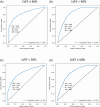Development and validation of algorithms to predict left ventricular ejection fraction class from healthcare claims data
- PMID: 38438250
- PMCID: PMC11098626
- DOI: 10.1002/ehf2.14725
Development and validation of algorithms to predict left ventricular ejection fraction class from healthcare claims data
Abstract
Aims: The use of large medical or healthcare claims databases is very useful for population-based studies on the burden of heart failure (HF). Clinical characteristics and management of HF patients differ according to categories of left ventricular ejection fraction (LVEF), but this information is often missing in such databases. We aimed to develop and validate algorithms to identify LVEF in healthcare databases where the information is lacking.
Methods and results: Algorithms were built by machine learning with a random forest approach. Algorithms were trained and reinforced using the French national claims database [Système National des Données de Santé (SNDS)] and a French HF registry. Variables were age, gender, and comorbidities, which could be identified by medico-administrative code-based proxies, Anatomical Therapeutic Chemical codes for drug delivery, International Classification of Diseases (Tenth Revision) coding for hospitalizations, and administrative codes for any other type of reimbursed care. The algorithms were validated by cross-validation and against a subset of the SNDS that includes LVEF information. The areas under the receiver operating characteristic curve were 0.84 for the algorithm identifying LVEF ≤ 40% and 0.79 for the algorithms identifying LVEF < 50% and ≥50%. For LVEF ≤ 40%, the reinforced algorithm identified 50% of patients in the validation dataset with a positive predictive value of 0.88 and a specificity of 0.96. The most important predictive variables were delivery of HF medication, sex, age, hospitalization, and testing for natriuretic peptides with different orders of positive or negative importance according to the LVEF category.
Conclusions: The algorithms identify reduced or preserved LVEF in HF patients within a nationwide healthcare claims database with high positive predictive value and low rates of false positives.
Keywords: Claims database; Heart failure; Left ventricular ejection fraction; Machine learning; Registry records.
© 2024 The Authors. ESC Heart Failure published by John Wiley & Sons Ltd on behalf of European Society of Cardiology.
Conflict of interest statement
D.L. received honoraria for consulting, lectures, or educational events from AstraZeneca, Bayer, Boehringer Ingelheim, Novartis, Pfizer, and Vifor. T.D. received honoraria for consulting, lectures, or educational events from Akcea Therapeutics, Alnylam Pharmaceuticals, AstraZeneca, Bayer, Boehringer Ingelheim, Novartis, Pfizer, Prothena, and Vifor and grants from Alnylam Pharmaceuticals, GSK, Neurimmune, Novartis, and Pfizer. F.R. received honoraria for consulting, lectures, or educational events from Abbott, Air Liquide, AstraZeneca, Bayer, Boehringer Ingelheim, Novartis, Novo Nordisk, Pfizer, Servier, and Vifor and grants from Air Liquide and Abbott. R.I. received honoraria for consulting, lectures, or educational events from AstraZeneca, Bayer, Boehringer Ingelheim, Novartis, Servier, and Vifor. M.D. and M.G. have no conflicts of interest.
Figures



Similar articles
-
Feasibility and accuracy of linking a heart failure registry to the national claims database using indirect identifiers.Arch Cardiovasc Dis. 2023 Jan;116(1):18-24. doi: 10.1016/j.acvd.2022.11.002. Epub 2022 Dec 9. Arch Cardiovasc Dis. 2023. PMID: 36549971
-
Development and Preliminary Validation of a Medicare Claims-Based Model to Predict Left Ventricular Ejection Fraction Class in Patients With Heart Failure.Circ Cardiovasc Qual Outcomes. 2018 Dec;11(12):e004700. doi: 10.1161/CIRCOUTCOMES.118.004700. Circ Cardiovasc Qual Outcomes. 2018. PMID: 30562067
-
Accuracy of Administrative Coding to Identify Reduced and Preserved Left Ventricular Ejection Fraction.J Card Fail. 2019 Jun;25(6):486-489. doi: 10.1016/j.cardfail.2019.01.019. Epub 2019 Feb 10. J Card Fail. 2019. PMID: 30743043
-
Left ventricular ejection fraction as therapeutic target: is it the ideal marker?Heart Fail Rev. 2017 Nov;22(6):641-655. doi: 10.1007/s10741-017-9624-5. Heart Fail Rev. 2017. PMID: 28601914 Review.
-
Heart failure with preserved ejection fraction: recent concepts in diagnosis, mechanisms and management.Heart. 2022 Aug 11;108(17):1342-1350. doi: 10.1136/heartjnl-2021-319605. Heart. 2022. PMID: 35022210 Review.
Cited by
-
Progression of Heart Failure in People with Type 2 Diabetes in Germany: An Analysis Using German Health Insurance Claims Data.J Health Econ Outcomes Res. 2024 Aug 27;11(2):58-65. doi: 10.36469/001c.120747. eCollection 2024. J Health Econ Outcomes Res. 2024. PMID: 39267887 Free PMC article.
References
-
- Bufalino VJ, Masoudi FA, Stranne SK, Horton K, Albert NM, Beam C, et al. The American Heart Association's recommendations for expanding the applications of existing and future clinical registries: A policy statement from the American Heart Association. Circulation 2011;123:2167–2179. doi:10.1161/CIR.0b013e3182181529 - DOI - PubMed
-
- McDonagh TA, Metra M, Adamo M, Gardner RS, Baumbach A, Böhm M, et al. 2021 ESC guidelines for the diagnosis and treatment of acute and chronic heart failure: Developed by the Task Force for the Diagnosis and Treatment of Acute and Chronic Heart Failure of the European Society of Cardiology (ESC). With the special contribution of the Heart Failure Association (HFA) of the ESC. Eur Heart J 2021;42:ehab368. doi:10.1093/eurheartj/ehab368 - DOI - PubMed
-
- Tuppin P, Rudant J, Constantinou P, Gastaldi‐Ménager C, Rachas A, de Roquefeuil L, et al. Value of a national administrative database to guide public decisions: From the système national d'information interrégimes de l'Assurance Maladie (SNIIRAM) to the système national des données de santé (SNDS) in France. Rev Epidemiol Sante Publique 2017;65:S149–S167. doi:10.1016/j.respe.2017.05.004 - DOI - PubMed
Publication types
MeSH terms
Grants and funding
LinkOut - more resources
Full Text Sources
Medical
Research Materials
Miscellaneous

